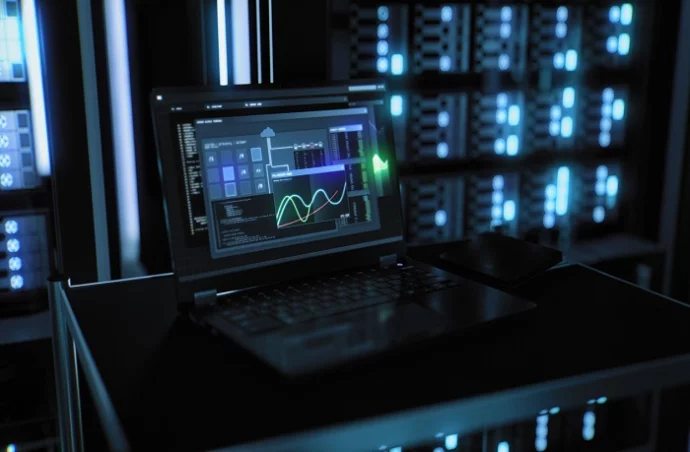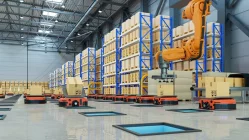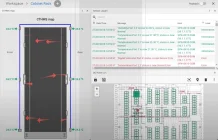How to Select Environmental Monitoring Sensors for a Data Centre EMS
Data centres and server rooms are dynamic environments. A ‘steady-state’ of operation is not always achievable due to server utilisation, environmental factors, planned maintenance, system downtime and emergencies. Smaller data centres and server rooms tend to have less investment in redundant systems and can be more susceptible to outages caused by a critical system failure or sudden changes in their operating environment.
What is an EMS?
An Environmental Monitoring System (EMS) consists of a monitoring unit that collects environmental data from connected sensors and detectors and provides alerts when analog measurements fall outside set parameter ranges, or there is a change of state to a digital input. In a server room or data centre environment, the principle environmental factors are temperature, humidity, and water leak detection. Additional factors including security and power availability.
Key Environmental Factors to Monitor in a Data Centre
The latest data centre annual outage report from the Uptime Institute states that a controllable factor in preventing downtime is investment in systems and training. Monitoring is one of the key systems noted where investment can lead to more hours of uptime and there are several key factors to consider when designing and environmental monitoring system for a server room or data centre.
More information:
A copy of the report is available from: https://uptimeinstitute.com/annual-outage-analysis-2021
Temperature Level Sensors
This is the most important environmental factor to monitor. All electronics devices generate heat. Overheating also kills electronics (over time) and can lead to a fire risk. Within a server rack, there is an ever present ‘clear and present danger’ of fire which can result in downtime and the loss of data.
This is a risk that can be managed by monitoring server cabinets for ‘hot-spots’ and taking corrective actions when they are identified. Improved air flow and equipment rearrangements within a server rack can help to lower temperatures and improve energy efficiency. Monitoring can be at the rack or room level, with the server racks arranged into hot and cold aisles, both of which are temperature monitored using the appropriately placed sensors. The ideal average operational temperature range being from 18 to 25⁰C.
Within most data centres and server rooms, around 45% of the operational budget goes on electricity to power cooling systems. Environmental monitoring helps to ensure that cooling systems are operating to their design parameters. Monitoring systems can also provide instant alerts to sudden temperature changes, whether at a rack or room level, allowing an emergency response.
More information:
https://www.cibsejournal.com/general/cost-model-data-centre-cooling/
Monitoring server room temperatures and taking corrective actions will also lead to improvements in energy efficiency. For most data centre operators, Power Usage Effectiveness (PUE) is key operational metric, comparing the energy used by the IT load over the energy used for IT and the critical systems.
Google runs possibly the most energy efficient data centres and run theirs at 26⁰C (80⁰F) and achieve a power usage effectiveness of 1.06, which is as near too perfect in terms of energy efficiency as you can achieve, so far.
In smaller data centres and server rooms, appropriately placed temperature sensors and the data they collect, can lead to automated changes in how the HVAC systems operate. Cooling levels can be automatically raised or lowered, in a response to temperature fluctuations. For smaller sites, temperature alerts can signal the need for additional temporary cooling including additional air handlers and even the need for portable air conditioners. Planned maintenance is one instance where the dynamics of the room can change and require environmental monitoring. Ad hoc works inside the facility, and the additional of more servers and storage devices to server racks are others.
More information on Google data centres and energy efficiency:
https://www.google.com/about/datacenters/efficiency/
What is the best temperature range for a server room?
At Server Room Environments, we follow the ASHRAE guidelines, the latest of which recommend for high-density systems a narrow temperature band of18°C/64.4°F to 22°C/71.6°F (as opposed to 18°C/64.4°F to 27°C/80.6°F). The allowable envelope having an upper limit of 25°C/77°F for class H1, instead of 32°C/89.6°F. Not only does this temperature range help to optimise energy efficiency, but it also provides a comfortable environment for IT managers, data centre engineers, cooling and UPS maintenance engineers to work within.
The latest ASHRAE guidelines can be viewed here:
https://journal.uptimeinstitute.com/new-ashrae-guidelines-challenge-efficiency-drive/
Humidity Level Sensors
Air conditioners and cooling systems manage water content (humidity) and within a server room or data centre, it is vital to operational performance that humidity levels are monitored. The ideal humidity range for electronic devices (servers, storage, and networking devices) is 40-60%.
- Low Humidity Levels (lower than 40%): can lead to dry air and result in a build-up of an electrostatic charge that can suddenly discharge if not earthed, leading to electronic component damage and sparks that could lead to a fire risk.
- High Humidity Levels (higher than 60%): can lead to a build-up of moisture on surfaces with the risk of corrosion and short-circuits.
Air conditioners and cooling systems should automatically adjust their performance to maintain pre-set humidity levels within a server room or data centre. However, as with temperature ‘hot-spots,’ build-up areas can occur leading to potential outage events.
Humidity level monitoring at specific sensor points within a data centre or server room, and even within server cabinets can help to quickly identify areas of concern. Alerts can also indicate that an air conditioning and cooling system is not performance to specification and may itself require maintenance and/or inspection. In extreme cases, additional dehumidifiers may be required as a temporary measure.
It is important to note that combined temperature and humidity sensors can be used in place of individual sensors for temperature and humidity. This can free-up sensor ports on an environmental monitoring base unit to allow more sensors to be deployed within an IT facility. Some sensors do not also have to be hardwired (RJ-45, CAT5/6) and can be deployed using wireless technology.
What is the optimal humidity level for a server room?
At Server Room Environments we recommend between 40% and 60%. In this range there is less risk of electro-static discharge, corrosion from a build-up of water moisture on surfaces, and less risk to operational performance and working life of critical systems.
Airflow Sensors
Constant airflow is vital to the cooling of a server room or data centre. Airflow sensors can be placed in the airflow paths, but they are not precision analog sensors as is the case with a temperature sensor, Airflow sensors are digital detectors and indicate, using a normally open (NO) or normally closed (NC) relay, where airflow is present or not. Lack of airflow can indicate a problem with a data centre computer room air conditioner (CRAC) or wall-mounted air conditioner in a server room. Any change of state leads to an alarm message, warning that some aspect of the cooling or air handing systems needs investigation.
Flood and Water Leakage Detection Sensors
HVAC systems (air conditioners and CRACs) can leak water into a server room or data centre environment. Sometimes this can be visible in wall mounted systems and drip trays used to manage such events and move the water away from electrical circuits and electronic devices, where it could result in a short-circuit, fire risk and downtime. Where raised access floors are used, leakages can be harder to detect. Nearby plumbing can also rupture or leak, adding a further source of water ingress into the protected space.
Water leakage detection relies on the use of rope sensors connected to an environmental monitoring base unit. The rope may be sensitive to a variety of liquids (water and glycols) allowing it to be also used to detect leaks from liquid cooling systems. There are two types of water detection rope. The first may only be able to detect an event or events but not locate this to a specific section. Locate water rope can provide this additional level of detection, allowing a faster response to the specification location. Once used the rope is dried and can be reused.
Most water leakage detection ropes are installed around a perimeter of a room and underfloor areas, near to specific server cabinets. Another type of water detection device is a spot-sensor. This is not a rope but a device that will alarm if liquid or moisture encounters the sensor and may be used in air conditioner drip trays or underneath a suspect air conditioner.
Access Control Sensors
Data centres and server rooms should be secure spaces and for some operations it is important to provide access control security at the server cabinet door level.
Access control not only helps to prevent unauthorised access but also to maintain a clean room, with less particulates (dust and dirt) in the air. Any particulates in the air will build-up in the servers and can lead to increased operational temperatures, requiring further cooling and energy usage. Particulates can include dirt from unclean foot water, human skin and any that are in the air outside the access-controlled doors.
Most environmental monitoring systems will include a digital I/O interface that will allow door contacts to be managed. Some incorporate more complex access control features, including control of MIFARE type access control cards and credentials. For some sites, room door control may be all that is required. For others, including colocation sites, rack level authorisation my be required.
CCTV cameras can add a further level of security to a server room. The cameras can be set for continuous or motion-detected operation, with their feeds viewable through the environmental monitoring system.
Power Availability Sensors
Critical power paths within a server room or data centre are normally protected by uninterruptible power supplies and these may be supported by a local standby power generator.
UPS systems and generators will provide communications for normal and alarm conditions using SNMP, MODBUS, and other protocols. Environmental monitoring systems can also be installed with additional sensors for:
- Mains and UPS Power Availability: power detectors can be installed to provide I/O signals to an environmental monitoring system as an additional safety measure. Power detectors use electromagnetic induction to detect the presence of not of an AC voltage. For small amperages, they may simply need to be placed over a power cable (clamped). For larger amperages, a current transformer (CT) is used around core wires within the power cable. Battery health indicators can also be installed to monitor for charge, discharge state, and provide predictive analysis as to the health of UPS and generator batteries.
- Standby Power Generator Fuel Tank Levels: generators will provide signals to allow them to be remotely started or stopped and alarms for certain conditions. These can be supplied through a digital I/O interface on an environmental monitoring system. Specific sensors can also be connected to monitor real-time fuel tank levels to ensure there is sufficient available to provide the expected runtime in the event of power outage or levels during a specific power loss event.
Incorporating UPS and generator signals into an environmental monitoring platform, allows for a comprehensive view of the critical infrastructure systems and environmental factors that should be monitored and controlled.
Alarm Reporting and Notification Alerts
There are several factors to consider in the design of a data centre environmental monitoring system. How alarms are reported, and the notification alerts can be as important as the choice of environmental sensors and detectors.
Most environmental monitoring systems will provide a software package to run on a local IP network or a cloud-based platform. The base units will also provide alarm and alert notifications via a range of protocols, allowing the devices to be incorporated into local building management systems (BMS) and data centre infrastructure management (DCIM) platforms.
When configuring the alarms and alerts it is important to decide on a distribution list and how the messages are to be provided. Temperature and humidity levels can be monitored over a range, with alarms only being triggered at outside set levels. Other environmental factors, such as water leakage or door security are not and simply alert when activated.
Alert messages can be set to be sent to key personnel distribution lists via email, text and even phone messages. Text messages are often the preferred method for data centre managers to ensure that key alarms are not missed amongst hundreds of emails.
Automated responses can also be configured within some platforms to alarm events using logic to shutdown or turn-on specific systems.
Summary
Just how many sensors and detectors and the types that need to be deployed in a server room or data centre EMS depends on the size of the facility, its physical room layout in terms of obstacles and obstructions, how the server cabinets are arranged (e.g., hot, and cold aisles) and the presence or not of high-compute zones with higher power usage and cooling needs.
A golden HVAC rule is that warm air rises, and cold air falls. Within a server cabinet, multiple sensors should be used with sets placed at the top, middle and bottom of a rack, and at the front and rear to provide a true cabinet map analysis and Delta-T calculation.
At the room level, sensors and detectors should be placed near to cooling and air conditioning systems, at known airflow hot spots within the room and in less open spaces, including under raised access floors and in ceiling voids. Ultimately your data centre EMS should ensure that you can react quickly to changes and take corrective actions. The data can also be used to improve energy efficiency and lower operating costs, leading to a fast return on investment for your data centre EMS.


























